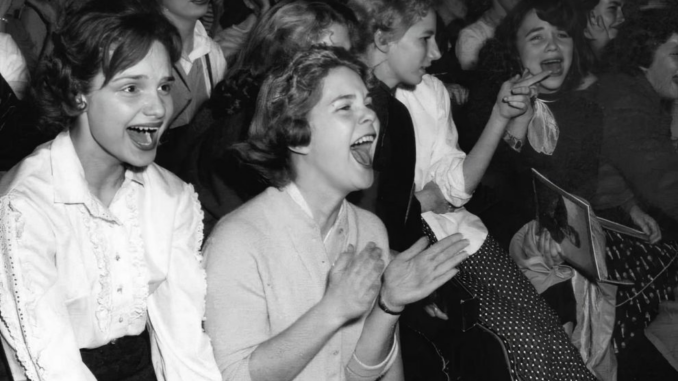
There was a time—long before streaming, before cell phones, and before we could record our favorite shows—when you had to be in front of the TV right on time or risk missing it forever.
And for countless American teenagers during the 1950s and early 1960s, that “must-see” moment happened every weekday afternoon.
It was called American Bandstand, and it was more than just a show.
It was an event.
A daily ritual.
And for many, it was the highlight of the day—something so special, we would do just about anything to make sure we didn’t miss it.
The Final Bell: The Race Begins
As soon as the school bell rang, the race was on.
Books were snapped shut. Desks scraped against the floor. Hallways filled with teenagers shouting goodbye to teachers and friends—but no one lingered long.
Why? Because Bandstand was starting soon.
Some kids ran down sidewalks with their bags swinging, cutting through backyards and hopping fences. Others jumped on bikes, hearts pounding like drumbeats. The lucky ones lived close to home; the rest just prayed the bus wouldn’t hit traffic. We all had one mission: get to the television before the first note played.
We didn’t want to miss Dick Clark’s smooth greeting, the record ratings, the dancing, or those beloved regulars we felt we knew personally—Justine, Bob, Arlene, Kenny, Carmen, and more.

The Living Room Stage
Shoes kicked off at the door. Books were dropped by the stairs. Sometimes we didn’t even say hello to our parents—we just ran straight to the TV, turned the dial, and dropped onto the living room rug, breathless but ready.
And there it was: the familiar stage, the crowd of teens already dancing, the spinning records, the laughter, the music.
American Bandstand didn’t just show us how to dance—it showed us how to feel like we belonged.
Even if you weren’t in Philadelphia, even if you were hundreds of miles away, the show made you feel like you were part of something real and exciting.
For those thirty minutes—or later, an hour—home felt like the center of the music world.

More Than Just Entertainment
Bandstand didn’t just entertain us—it taught us.
We learned the latest dances (and practiced them endlessly in front of mirrors).
We picked up fashion ideas (rolled socks, full skirts, slicked-back hair).
We discovered artists we’d never heard of before, and we ran out to buy their records.
Most of all, we connected—with the show, with each other, with the feeling that we were part of a bigger moment.
It wasn’t just about the music. It was about growing up, finding our place, and seeing ourselves reflected on the screen—even if just for a few fleeting moments each day.
The Conversations That Followed
The next morning at school, Bandstand was always the first thing we talked about:
“Did you see what Arlene was wearing?”
“I loved that new song they played!”
“Did you see how fast they rated that record?”
Those conversations weren’t just idle chatter. They were how we formed friendships, how we found our tribes—rockers, doo-wop fans, slow-dance dreamers.
American Bandstand helped shape who we were, not just musically, but socially.
It gave us something to rally around.
It made us feel like we had something special—even if all we did was rush home in time to watch it.
Looking Back with a Smile
Now, decades later, many of us still remember that feeling.
The sound of the school bell. The slam of a locker door. The wind in our face as we ran home.
The flickering TV screen. The music. The dancers.
And maybe most of all—the sense of anticipation.
The feeling that something wonderful was about to happen.
It’s hard to explain to younger generations what it meant to rush home just to watch a TV show.
But for us, it was never just a show.
It was a piece of our day.
A piece of our identity.
And now, a piece of our hearts.
━━━━━━━━━━━━━━━━━━━━━━━━━━━
💬 Do you have a special memory or question about American Bandstand?
Whether it’s a favorite dancer, a song that stayed with you, or a quiet moment you never forgot—we’d love to hear it.
📝 Share your story with us here: